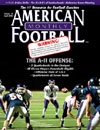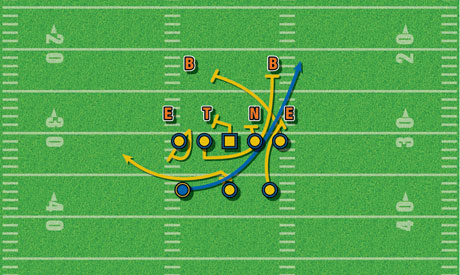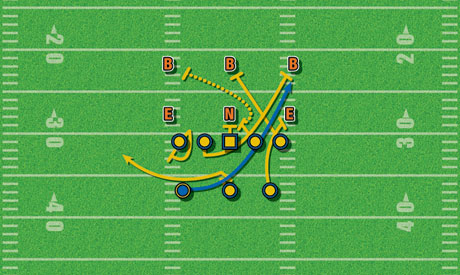AMERICAN FOOTBALL MONTHLY THE #1 RESOURCE FOR FOOTBALL COACHES
Article CategoriesAFM Magazine
|
Running the Spread in the Red Zoneby: Michael Parker© More from this issue It was only two years ago that many coaches around the country turned their eyes to the University of Arkansas to see if Gus Malzahn’s Hurry-Up No-Huddle offense could make the jump from high school to college. Truly it was a trial by fire in the brutal SEC. Now, after a year in Fayetteville and one leading the Tulsa Golden Hurricane’s offense, the jury has reached a verdict. It works. Tulsa quietly finished second in the nation this past fall in touchdowns with 79. Only Oklahoma, with 80, scored more. One of the major reasons Tulsa did so well in 2007 lies in their efficiency in the red zone. They get touchdowns, not field goals and led all FBS teams in that category. “We’re really not built from a mentality to kick field goals. We’re not happy with that. At least that isn’t the mindset we want our players to have.” HOW CAN A SHOTGUN OFFENSE SCORE TDs NEAR THE GOAL LINE? Conventional thinking is that a spread offense is fine for getting down to the goal line but when you get it in that close, you’d better put in your big guys and pound the ball. Malzahn is a disciple of the Spread, and his offense’s success last season proves that even the shotgun has a place inside the 10. “Most head coaches that are a little fearful of doing some of this spread stuff down close is just the fact that it isn’t what they are used to,” says Malzahn. “It isn’t in their comfort zone.” But it works. THE 5 KEYS TO RUNNING THE SPREAD IN THE RED ZONE Malzahn follows five key principles to operate his Spread offense in the red zone. 1. Break the red zone down into even smaller parts. “The first thing we do is break the field – even the red zone – into different parts” says Malzahn. “We start at the 40 and we have landmarks that go all the way down to the goal line. “We are very specific. We have certain plays for certain landmarks on the field. We have the field broken down by yard lines, especially from the 10-yard line in. We have things broken down by yard lines, by hash, by down and distance, etc. We are very specific on the particular plays that we call. “We go 40-30, 30-20, 20-10, and we usually have two runs and three passes at each landmark. And when we get down inside the 10-yard line, then that is when we get very specific. On the hash, which yard line, down and distance, etc., and we have a lot more options there.” 2. Do not change your offensive philosophy just because you are getting closer to the end zone. Malzahn feels that one of the biggest mistakes many coaches make is they disband the system that has gotten them down into scoring position just because traditionally teams put the big guys in near the goal line. “The big thing is our philosophy to not change,” says Malzahn. “We are a Spread No-Huddle offense team. We’re going to do the same thing, even when the field condenses. “We’ll definitely go to our strengths. If they take that away, then obviously we want to have an answer. We are going to spread the field and go to our strengths. One year it might be running behind our right side, and the next year it may be a QB that can run the football. You need to do what you are good at. If you are a 21 personnel team and you run the Iso and the Blast, then you do those things down in the red zone.” Another component of the Tulsa version of the Spread is the Hurry-Up, No-Huddle. Malzahn credits a lot of his team’s success near the goal line to the fact that defenses are usually tired, and stuck in their base personnel, from the fast pace of the Tulsa offense. Tulsa’s No-Huddle style forces the same players on defense to play from the first snap to the last snap in a series with no substituting. “One thing we’ve found is that with our pace, defenses and defensive coaches have their tendencies in the red zone more than they normally do in the open field,” says Malzahn. “I feel that is a huge advantage for us with our pace. If we can get going fast enough that we have a really good idea of what we’re probably going to get and that is why we are so specific with our landmarks and our plays in different areas going into the game.” 3. You’ve got to be able to run the football. But, surely, Tulsa doesn’t intend to line up in the shotgun and run Power, do they? Yes. They do. “We feel real good about our runs, even though we run them out of the shotgun,” says Malzahn. “We do some plays from up under center, but mostly we run our shotgun. “I am like a lot of people. I like to run the Power. We just happen to do it out of the shotgun. “We can do it different ways and get the ball to different people, but up front is it just basically the Power G. Power is good for this area of the field. It is a downhill run, a gap scheme. What I like about it is that even if they blitz you, you have an answer. It is good against the blitz. That has probably been the bread and butter going back to when I ran this system in high school.” (See Diagrams 1 & 2)
Tulsa runs their Power play many different ways (motion, varying the ball carrier, etc.). But, the scheme is very sound. “I also believe you got to take what they give you, whether that means run or pass,” says Malzahn. “But in the Spread, we feel like we have to be able to run the football. If you have a somewhat balanced attack, no matter what your offensive philosophy is, we believe that you have to be able to run the ball. I think we actually ran the ball the exact number of times we passed the ball last year.” 4. But, you have to be able to throw when they stop the run. Play action works well in the red zone, of course. And the quick game is always a safe choice. But… “As for routes, it just depends on what they are doing,” says Malzahn. “There are so many different things people do now with combination coverages. You’ve got your base quarters that you see a lot. They try to match up. Then you’ve got your man, for the most part. Very few teams are going to play Cover 2 inside the 10. It just depends on what they are giving you. “We have specific routes designed against specific defenses and my quarterback and receivers just need to recognize the coverage they are giving us and we adjust accordingly. We adjust off what they give us. It is built into our passing game.” A FEW REMINDERS FOR THE QBs “First thing I teach our quarterbacks is to make sure they don’t turn the ball over,” says Malzahn. “The stupidest thing you can do is turn the ball over down there where you can get points. “The other thing I try and teach my guys is to make their decisions based on game situations. We have a pretty aggressive style, but in certain parts of the field like the red zone, or at certain times in the game, we have to make more conservative decisions. To work on that, during the week we give them down and distance and some of these things to think about in practice. “But, the two main things they must remember are to protect the football and make good decisions.” 5. Practice, practice, practice red zone game situations during the week. Tulsa spends a bunch of time making sure that they are prepared for their upcoming red zone game situations. “What has been great for us is our head coach is a firm believer in practicing red zone offense and defense,” says Malzahn. “And I would bet that we practice that specifically as much as any team in America. We spend quality time in practice on it, especially in the spring. Whatever you practice, you get good at. Our head coach really does a great job in preparing our offense and defense practice time-wise. “Wednesday is our red zone day for us. So we spend time on Wednesday and then we come back and then cover it again on Thursday.” A WORD ON DEFENSES IN THE RED ZONE “Defenses are pretty consistent the closer we get down in there, but more teams are playing their base defense against the spread,” says Malzahn. “It isn’t like they are playing against 32 personnel, where everyone gets packed down in there. We spread them out, and most teams stay in their base type defense personnel wise.” Perfect for the five keys. Over the years, Gus Malzahn has taken a lot of conventional wisdom and ignored some – like goal line formations and huddles. As a result, Tulsa has showed that maybe the so-called experts really don’t know it all. And with more touchdowns scored than just about everyone else in America, Tulsa’s Spread offense truly was a Golden Hurricane in the red zone in 2007. |
|
| HOME |
MAGAZINE |
SUBSCRIBE | ONLINE COLUMNISTS | COACHING VIDEOS |
Copyright 2024, AmericanFootballMonthly.com
All Rights Reserved






